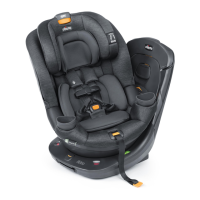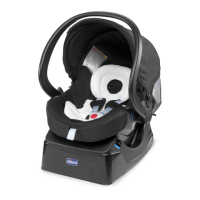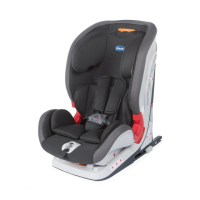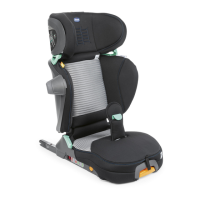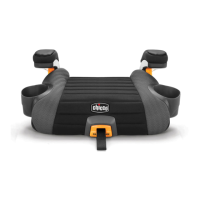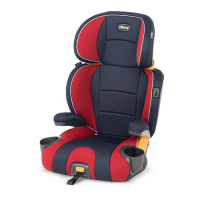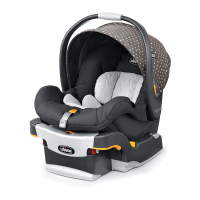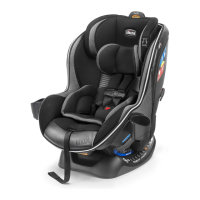Do you have a question about the Chicco Fit2 Cienna and is the answer not in the manual?
Instructions on how to register your child restraint for safety recall notifications.
Specifies the minimum and maximum weight and height requirements for using the restraint.
Details age and developmental milestones for using different base stages and positioners.
Advises consulting a doctor for premature infants due to potential breathing difficulties.
Ensures the child meets weight, height, and developmental requirements for the restraint.
Verifies safe seating location, proper leveling, and snug fit in the vehicle.
Confirms correct installation and securing the child with the harness.
Emphasizes the importance of reading and understanding all instructions and warnings.
Reiteration of weight, height, and headrest position for child fit.
Details how to properly and snugly secure the child with the harness to prevent ejection.
Warns against placing the restraint in front of active airbags and advises rear-facing installation.
Reminds users to always check for a tightly secured restraint before each use.
Prohibits installation with inflatable seat belts due to injury risk.
Covers never leaving a child unattended and avoiding suffocation or strangulation hazards.
Advises against using damaged, modified, or expired restraints.
Ensures all vehicle occupants are restrained before traveling to prevent injuries.
Advises securing loose objects in the vehicle to prevent them from causing injury.
Warns about hot surfaces and children playing with seat belts.
Provides contact information for customer support and questions.
Recommends contacting a Child Passenger Safety Technician for installation guidance.
Details warnings about front airbags and the safety of rear seating positions.
Discusses compatible vehicle seating positions and avoiding folded seat backs.
Specifies the maximum allowable overhang of the restraint base on the vehicle seat edge.
Mentions LATCH as the simplest installation method.
Explains shoulder belt retractors and the use of lock-offs.
Lists specific types of vehicle seat belts that must not be used for installation.
Specifies the required spacing for LATCH lower anchors for this restraint.
Defines LATCH and clarifies it replaces, not supplements, the vehicle belt.
Describes the vehicle's lower anchor points and top tether anchor.
Details the weight range (4-35 lbs) and height criteria for Stage 1.
Outlines who should use Stage 1 based on weight, height, and head position.
Instructions on how to set the base lever to Stage 1 for a reclined position.
Details the weight range (15-35 lbs) and height criteria for Stage 2.
Outlines who should use Stage 2 based on development, weight, height, and head position.
Warns that infants may have difficulty breathing in the upright Stage 2 position.
Instructions on how to set the base lever to Stage 2 for an upright position.
Advises checking vehicle seating positions and ensuring a level surface.
Instructions on selecting the correct base stage based on child criteria.
Guides users on using the bubble level indicator and leveling foot to achieve proper recline.
Instructions for storing LATCH connectors when not in use.
Warning about securing unused seat belts behind the restraint with inflatable belts.
Steps to release LATCH straps and remove connectors from storage.
Guides on locating vehicle LATCH anchor bars and attaching connectors.
Instructions for tightening LATCH straps while pressing the base into the seat.
Instructions for rolling and storing the LATCH release strap.
How to check the base for snugness and ensure no movement over 1 inch.
Step-by-step guide to threading the vehicle seat belt through the base belt path.
Instructions for buckling the seat belt and removing slack from the lap portion.
Detailed steps to remove all slack from the vehicle lap belt.
Instructions for sliding the shoulder belt into the lock-off mechanism.
Checks to ensure the installation is snug and secure.
Step-by-step guide to threading the vehicle lap belt through the base belt path.
Instructions for buckling the vehicle lap belt.
Detailed steps to remove all slack from the vehicle lap belt.
Checks to ensure the installation is snug and secure.
Reminds users to determine the best base stage for their child before attaching.
Step-by-step instructions for placing the carrier into the base.
Guidance on pushing down the carrier to ensure it locks onto the base hooks.
Instructions to check for secure attachment by lifting the carrier.
Comprehensive checks for snugness, level, and head position.
Warnings regarding infant breathing and using non-locking vehicle belts.
Guidance on selecting vehicle seats and achieving proper leveling without the base.
Instructions for threading and securing the vehicle's lap-shoulder belt through the seat belt guide.
Steps to pull shoulder belt webbing and engage the vehicle belt's locking mode.
How to remove slack from the lap belt and check the installation's snugness.
Explains the function of the optional shoulder belt guide for added stability.
Steps for threading and securing the shoulder belt around the carrier using the guide.
Checks to ensure the shoulder belt guide installation is secure and the restraint is level.
How to remove slack from the shoulder belt and check the installation's snugness.
Instructions for threading and securing the vehicle's lap belt through the seat belt guide.
Details using the seat belt guide for proper lap belt positioning.
How to remove slack from the lap belt and check the installation's snugness.
Steps to loosen the harness by pressing the adjuster button and releasing the buckle.
How to position the child correctly in the carrier for harnessing.
Ensures harness straps are flat, untwisted, and resting against the child's back.
Guides on adjusting the head rest so harness slots are at or below shoulder level.
Advises against bulky clothing or blankets interfering with harness tightness.
Instructions for pulling harness straps snug around the child's waist and shoulders.
Steps to insert buckle tongues and ensure they are securely latched.
Instructions for snapping the chest clip to secure the harness.
Emphasizes that harness straps must lie flat and be free of twists.
Detailed instructions for pulling the adjuster strap to achieve a snug harness fit.
How to check if the harness is too loose by pinching the strap at the shoulders.
Guides on positioning shoulder pads and the chest clip correctly.
Verifies harness is snug, without slack, and correctly positioned.
Ensures chest clip is positioned correctly and avoids bulky clothing.
Checks for proper newborn positioner use and strap flatness.
Instructions on how to release the carrier from the base using the handle.
Steps for properly storing LATCH connectors in the base compartments.
Details the weight limit (4-11 lbs) and warns against using other positioners.
Step-by-step guide for correctly placing and securing the newborn positioner.
Explains the head support function and how to install the insert.
Describes the three handle positions and rules for vehicle use.
Instructions for removing and reinstalling the crotch strap into different positions.
Ensures the crotch strap retainer is flat and the strap is secure.
Warning against using the restraint if any part of the harness is damaged.
Guides on how to adjust, remove, and reattach the canopy.
Confirms the restraint is certified for air travel and specifies forward-facing seat use.
Instructions to install the carrier on an aircraft using a vehicle lap belt.
Advises against bleach, solvents, lubricants, and using the restraint without a seat pad.
Details how to clean fabrics by spot cleaning, hand washing, or machine washing.
Specific guidance for cleaning shoulder pads, plastics, harness, LATCH straps, and hardware.
Instructions on how to register your child restraint for safety recall notifications.
Specifies the minimum and maximum weight and height requirements for using the restraint.
Details age and developmental milestones for using different base stages and positioners.
Advises consulting a doctor for premature infants due to potential breathing difficulties.
Ensures the child meets weight, height, and developmental requirements for the restraint.
Verifies safe seating location, proper leveling, and snug fit in the vehicle.
Confirms correct installation and securing the child with the harness.
Emphasizes the importance of reading and understanding all instructions and warnings.
Reiteration of weight, height, and headrest position for child fit.
Details how to properly and snugly secure the child with the harness to prevent ejection.
Warns against placing the restraint in front of active airbags and advises rear-facing installation.
Reminds users to always check for a tightly secured restraint before each use.
Prohibits installation with inflatable seat belts due to injury risk.
Covers never leaving a child unattended and avoiding suffocation or strangulation hazards.
Advises against using damaged, modified, or expired restraints.
Ensures all vehicle occupants are restrained before traveling to prevent injuries.
Advises securing loose objects in the vehicle to prevent them from causing injury.
Warns about hot surfaces and children playing with seat belts.
Provides contact information for customer support and questions.
Recommends contacting a Child Passenger Safety Technician for installation guidance.
Details warnings about front airbags and the safety of rear seating positions.
Discusses compatible vehicle seating positions and avoiding folded seat backs.
Specifies the maximum allowable overhang of the restraint base on the vehicle seat edge.
Mentions LATCH as the simplest installation method.
Explains shoulder belt retractors and the use of lock-offs.
Lists specific types of vehicle seat belts that must not be used for installation.
Specifies the required spacing for LATCH lower anchors for this restraint.
Defines LATCH and clarifies it replaces, not supplements, the vehicle belt.
Describes the vehicle's lower anchor points and top tether anchor.
Details the weight range (4-35 lbs) and height criteria for Stage 1.
Outlines who should use Stage 1 based on weight, height, and head position.
Instructions on how to set the base lever to Stage 1 for a reclined position.
Details the weight range (15-35 lbs) and height criteria for Stage 2.
Outlines who should use Stage 2 based on development, weight, height, and head position.
Warns that infants may have difficulty breathing in the upright Stage 2 position.
Instructions on how to set the base lever to Stage 2 for an upright position.
Advises checking vehicle seating positions and ensuring a level surface.
Instructions on selecting the correct base stage based on child criteria.
Guides users on using the bubble level indicator and leveling foot to achieve proper recline.
Instructions for storing LATCH connectors when not in use.
Warning about securing unused seat belts behind the restraint with inflatable belts.
Steps to release LATCH straps and remove connectors from storage.
Guides on locating vehicle LATCH anchor bars and attaching connectors.
Instructions for tightening LATCH straps while pressing the base into the seat.
Instructions for rolling and storing the LATCH release strap.
How to check the base for snugness and ensure no movement over 1 inch.
Step-by-step guide to threading the vehicle seat belt through the base belt path.
Instructions for buckling the seat belt and removing slack from the lap portion.
Detailed steps to remove all slack from the vehicle lap belt.
Instructions for sliding the shoulder belt into the lock-off mechanism.
Checks to ensure the installation is snug and secure.
Step-by-step guide to threading the vehicle lap belt through the base belt path.
Instructions for buckling the vehicle lap belt.
Detailed steps to remove all slack from the vehicle lap belt.
Checks to ensure the installation is snug and secure.
Reminds users to determine the best base stage for their child before attaching.
Step-by-step instructions for placing the carrier into the base.
Guidance on pushing down the carrier to ensure it locks onto the base hooks.
Instructions to check for secure attachment by lifting the carrier.
Comprehensive checks for snugness, level, and head position.
Warnings regarding infant breathing and using non-locking vehicle belts.
Guidance on selecting vehicle seats and achieving proper leveling without the base.
Instructions for threading and securing the vehicle's lap-shoulder belt through the seat belt guide.
Steps to pull shoulder belt webbing and engage the vehicle belt's locking mode.
How to remove slack from the lap belt and check the installation's snugness.
Explains the function of the optional shoulder belt guide for added stability.
Steps for threading and securing the shoulder belt around the carrier using the guide.
Checks to ensure the shoulder belt guide installation is secure and the restraint is level.
How to remove slack from the shoulder belt and check the installation's snugness.
Instructions for threading and securing the vehicle's lap belt through the seat belt guide.
Details using the seat belt guide for proper lap belt positioning.
How to remove slack from the lap belt and check the installation's snugness.
Steps to loosen the harness by pressing the adjuster button and releasing the buckle.
How to position the child correctly in the carrier for harnessing.
Ensures harness straps are flat, untwisted, and resting against the child's back.
Guides on adjusting the head rest so harness slots are at or below shoulder level.
Advises against bulky clothing or blankets interfering with harness tightness.
Instructions for pulling harness straps snug around the child's waist and shoulders.
Steps to insert buckle tongues and ensure they are securely latched.
Instructions for snapping the chest clip to secure the harness.
Emphasizes that harness straps must lie flat and be free of twists.
Detailed instructions for pulling the adjuster strap to achieve a snug harness fit.
How to check if the harness is too loose by pinching the strap at the shoulders.
Guides on positioning shoulder pads and the chest clip correctly.
Verifies harness is snug, without slack, and correctly positioned.
Ensures chest clip is positioned correctly and avoids bulky clothing.
Checks for proper newborn positioner use and strap flatness.
Instructions on how to release the carrier from the base using the handle.
Steps for properly storing LATCH connectors in the base compartments.
Details the weight limit (4-11 lbs) and warns against using other positioners.
Step-by-step guide for correctly placing and securing the newborn positioner.
Explains the head support function and how to install the insert.
Describes the three handle positions and rules for vehicle use.
Instructions for removing and reinstalling the crotch strap into different positions.
Ensures the crotch strap retainer is flat and the strap is secure.
Warning against using the restraint if any part of the harness is damaged.
Guides on how to adjust, remove, and reattach the canopy.
Confirms the restraint is certified for air travel and specifies forward-facing seat use.
Instructions to install the carrier on an aircraft using a vehicle lap belt.
Advises against bleach, solvents, lubricants, and using the restraint without a seat pad.
Details how to clean fabrics by spot cleaning, hand washing, or machine washing.
Specific guidance for cleaning shoulder pads, plastics, harness, LATCH straps, and hardware.
| Category | Car Seat |
|---|---|
| Weight Limit (Rear-facing) | 4-35 lbs |
| Installation | LATCH or seat belt |
| Harness Type | 5-point harness |
| Stroller Compatibility | Compatible with Chicco strollers |
| Seat Type | Convertible |
| Reclining Positions | Multiple positions |
| Safety Features | Side-impact protection, energy-absorbing foam |

